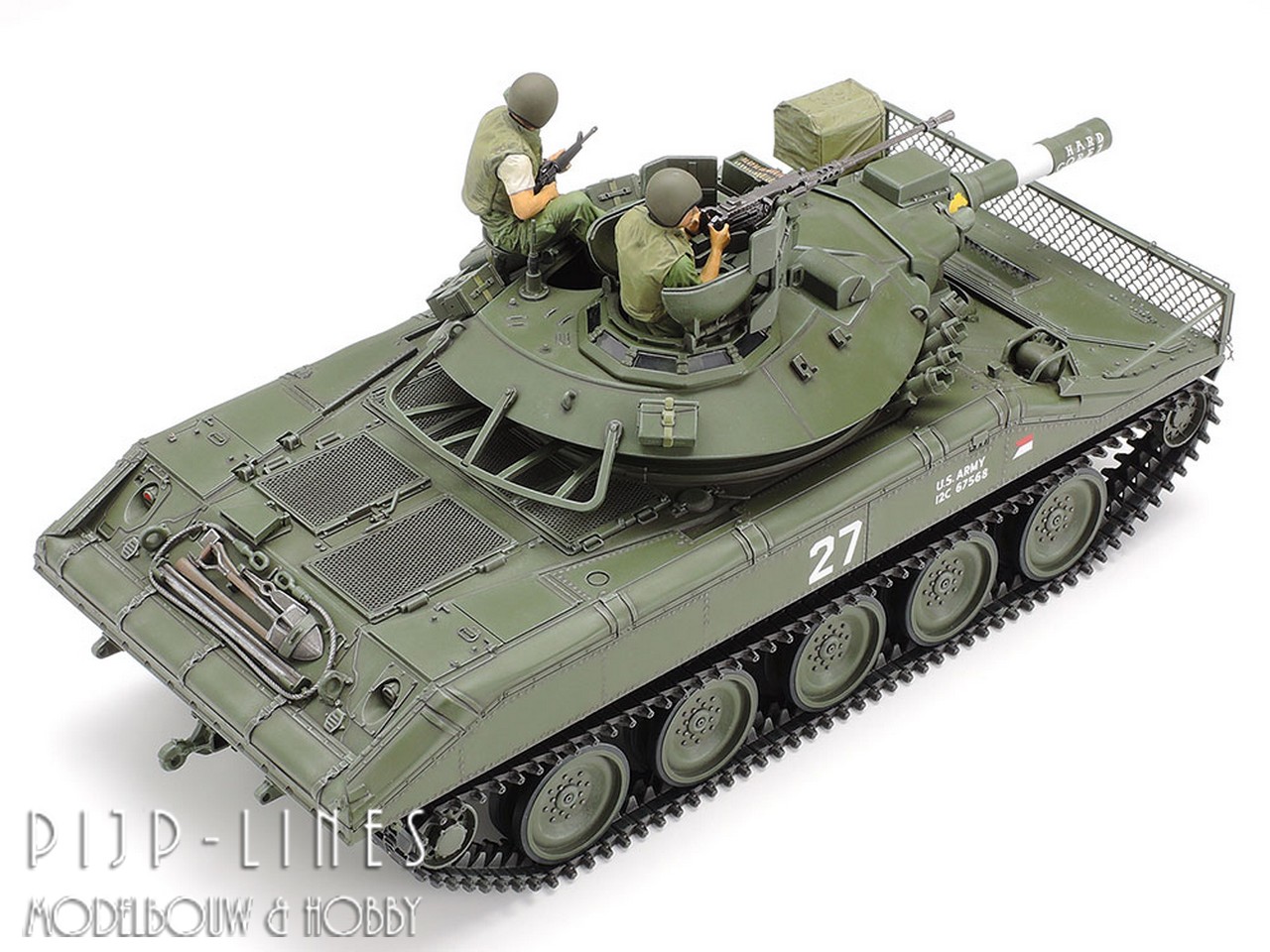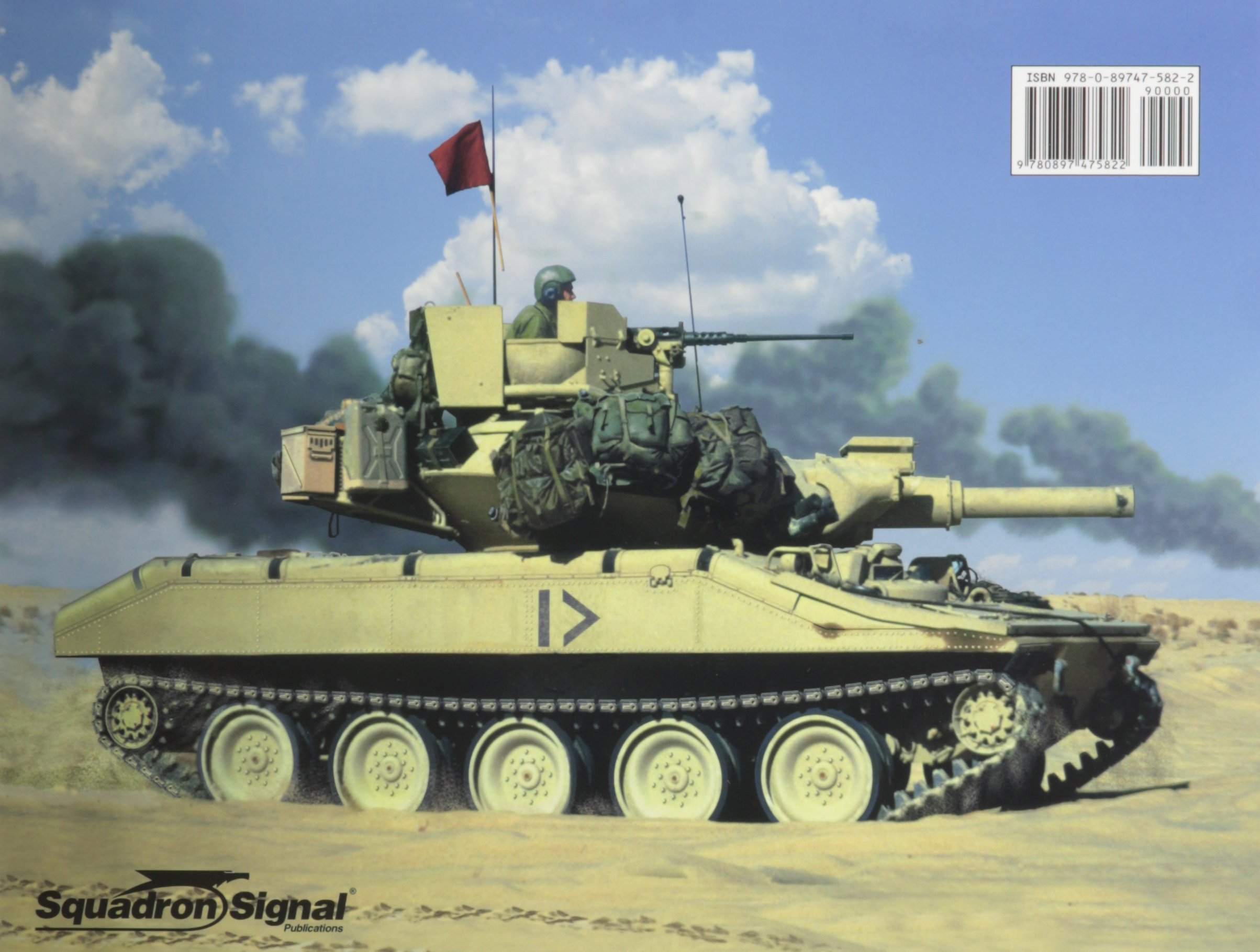M 551 Sheridan - The M551 "Sheridan" AR/AAV (Armored Reconnaissance/Airborne Assault Vehicle) is a light tank developed by the United States and named after General Philip Sheridan, famous in the American Civil War. It was designed to land by parachute and swim across rivers. It is equipped with an advanced but disruptive M81 / M81 Modified / M81E1 152 mm cannon / launcher, which fires conventional guns and MGM-51 Shillelagh guided anti-tank mines.
The M551 Sheridan entered service with the United States Army in 1967. At the suggestion of Geral Creighton Abrams, Commander of the United States, Military Assistance Command Vietnam, at the time, the M551 was released from military service in South Vietnam in January 1969. In the year, M551s were transferred to units in Europe and South Korea.
M 551 Sheridan

Sheridan saw a lot of combat in the Vietnam War, where the problems with the platform became apparent, especially its lack of survivability and reliability.
A Left Front View Of An M551 Sheridan Light Tank Modified To Resemble A Soviet Bmp1 Mechanized Infantry Combat Vehicle. The Vehicle Is Used By The 177th Armored Brigade In Their Role
From the experience in Vietnam, the Army realized the error of the Sheridan, and after the war in 1975 began to remove the vehicle from its units in 1979. The small fleet of vehicles remained in the 82nd Airborne Division and the National Guard. Various innovation programs were successfully implemented to increase Sheridan's credibility. Problems continued with the 152 mm gun/launcher, and various attempts were made to replace it with a standard model. Sheridan wt ing to serve in the invasion of Panama and the Gulf War. The Army sought to replace the Sheridan with the M8 Armored Gun System, but it was canceled in 1996, ending its development. Sheridan was retired without replacement in 1996. The Army acquired the M1128 Mobile Gun System to meet requirements, but this is being retired in 2022. Currt Army Mobile Protected Firepower light tank acquisition program.
A large number of Sheridans are kept in service at the National Training Cter (NTC) at Fort Irwin, California and as Armor Officer Basic training at the Armor Training Cter, located at Fort Knox, Kentucky. He served as an anti-Soviet armored unit (OPFOR) to train US troops in simulated tanks in tank-armored warfare to test their desert attacks. He later resigned from NTC in 2003.
During World War II, the US Army brought the M41 Walker Bulldog into service to fill the light tank. The life of M41 is short; at 25 tons it is considered too heavy for a true light tank, and has some short trips.
Plans were started to build a lighter replacement to mount the same gun, the T71 and T92. The T92 looks the most promising of the two. However, when the prototype was being tested, information about the Soviet PT-76 light tank became available. The PT-76 is amphibious, and soon there was a demand that US light tanks could also swim. The T92 could not be easily replaced in this role, so the Army canceled the program in 1958.
Tamiya 56042 U.s. Airborne Tank M551 Sheridan Full Option Kit @ Nuremberg Toy Fair 2019
In January 1959, the first concept studies began for an armored reconnaissance/air strike vehicle that would replace the M41 and M56 Scorpion self-propelled guns.
By October 1959, twelve proposals had been received by the Ordnance Tank Automotive Command. Two applications were selected in December: One from the Cadillac Motor Car Division of General Motors Corporation, and a joint venture from AAI Corporation and Allis-Chalmers Manufacturing Company. Mockups of all proposals were reviewed in May 1960.
The AAI representative has a crew of three, and weighs close to the ten-ton weight limit specified in the requirements. The Cadillac design is only slightly heavier, with four crew members. The three-man turret of the Cadillac proposal was found to be more efficient than the two-man turret proposed by the AAI. The weight limit is reset at 15 tons.

In June 1960, the Cadillac Motor Car Division signed a contract to develop the concept, designating the AR/AAV XM551. In August 1961, the Secretary of the Army approved the name "Sheridan," after Major General Philip Sheridan.
M551 Sheridan Airborne Light Tank
The decision to use a 152 mm caliber XM81 gun instead of a conventional gun was due to weight savings. The XM81 weighs about half the weight of the 105 mm caliber M68, and can fire conventional bullets and cartridges. Testing of the XM81 began at the Erie Army Depot in late 1961.
In 1962, the Army realized that the MGM-51 Shillelagh missile system would not be ready for the Sheridan, and then considered several other missile systems. These include 76 mm, 90 mm and 105 mm options, as well as cam systems such as TAC and TOW. The Army then decided to support Sheridan with 152 mm conventional rounds until Shillelagh was ready.
The first of twelve pilots was delivered in June 1962. Pilots 1–3 comprised the first generation. With the second generation drivers 4-6, the band tracks were replaced with single-pin link type tracks.
The XM551 test bed turret has a gun-launcher attached to the M41 chassis, which was first tested in August 1962 at the Aberdeen Proving Ground.
M551 Sheridan Vietnam War Airborne Tank 1/35 Tamiya (tam35365)
In the 1960s the Army also produced the MBT-70 main battle tank by West Germany. The US Army no longer uses heavy, medium, and light tanks. In 1960, with the elimination of the last heavy tank battalion (M103), and the new M60 series of tanks, the United States Army adopted the main battle doctrine (MBT); One tank fills all combat roles.
The US Army still maintains the M41 Walker Bulldog light tank in the Army National Guard, but in addition to the units undergoing the transition, regular troops include the MBT. Fearing that Congress would refuse to fund the two tank development programs, the Army decided to select the Sheridan as an armored reconnaissance vehicle rather than a light tank.
The Army also believes that "tank" is too much to lead to a main battle tank, a different role, so the new program is officially described as "Armored Assault / Airborne Vehicle."

In April 1965, the Army awarded a four-year, $114.5 million contract to the Cadillac Gage division of General Motors (GM) to manufacture the M109 and XM551 Geral Sheridan howitzers.
Members Of The 11th Armored Cavalry Deploy Around An M551 Sheridan Light Tank While Guarding The Border Between East And West Germany. An Observation Tower Is In The Background
Limited production was authorized in May, and it was designated as "Standard A" in May 1966. Production took place at the Cleveland Army Tank Automotive Plant. The first two production units were delivered to the Army in July.
During development, the Marine Corps evaluated the Sheridan as a replacement for the M50 Ontos. The Corps decided that the Sheridan would be too expensive.
In d, 1,662 Sheridans were built between 1966 and November 1970. The total cost of the M551 program was $1.3 billion.
The M81 rifle had a problem with cracking occurring near the breech after repeated firing, a problem that was followed by a "button" on the bullet that ran into a slot cut in the barrel.
M551 Sheridan Gulf War Wa
Many in the field were modified to help solve the problem, but later the modified M81E1 was introduced with a shallower slot, along with a proper adjustment of the missile, which cured the problem.
The gun has also been criticized for having too much weight on the car, the second and third road wheels are exposed from the ground when the main gun is fired.
In March 1967, the 105 mm howitzer XM103E7 and the 76 mm gun were installed in the M551 tower on Rock Island Arsal. No configuration is accepted.

In January 1969, two squadrons (54 Sheridans) were transferred to the Republic of South Vietnam and assigned to the 3rd Squadron, 4th Cavalry and another squadron of the 11th Armored Cavalry Regimt for combat trials.
M551 Sheridan Armored Reconnaissance/airborne Assault Vehi…
In March 1969, after the Army requested secrecy in refusing to release the cost of the program, officials at the Government Accountability Office (GAO) said the development cost had reached $10.3 billion. Congressman Samuel S. Stratton criticized military officials for the high cost of the program, and accused officials of hiding cost figures to cover their "appalling ignorance".
A GAO report released in May indicated that the Army had rushed the project to avoid budget scrutiny, even though it appeared in May 1966 that tankless bombs were easily cooked. The problem has been solved with an air-compression system that forces the rest of the hot gun out of the breech, the Army told Congress. The army said Sheridan had done so well that he was planning to send hundreds more.
A DRM report in July revealed $1.2 billion was wasted on the M60 and Sheridan. The report said some were injured in the Vietnam War because of Sheridan's design flaws, and said the tank was not ready for that battle "without the costly and time-consuming costs."
The vehicle is designed to mount a gun with a steel turret and an aluminum frame. Although the hull could handle heavy guns up to 12.7 mm AP,
M551 Sheridan Tank On Display.this Tank Was Used During The Vietnam War Stock Photo
Easily handled by a rocket-propelled grenade (RPG), which can destroy a vehicle if spalling catches a caseless main gun round. Like the M113 personnel carrier, it is vulnerable to mines.
The ability to swim is provided by a flotation scree, similar to the one used
Hp m 551, 06b 133 551 m, din 551, cli 551, 551 0207f, levis 551, 917 551, tze 551, sheridan m, hp 551, pixma 551, 551
0 Comments